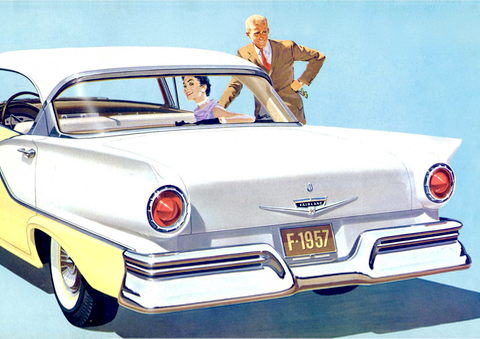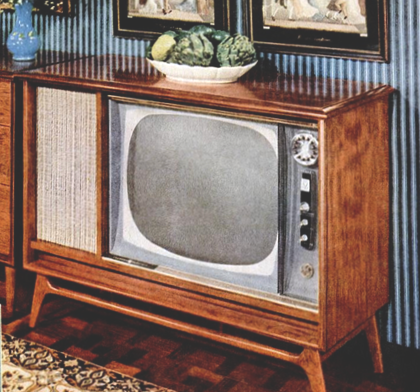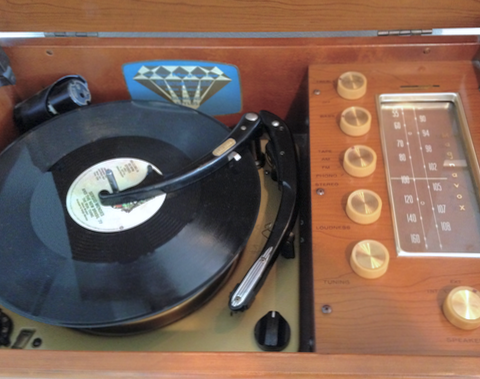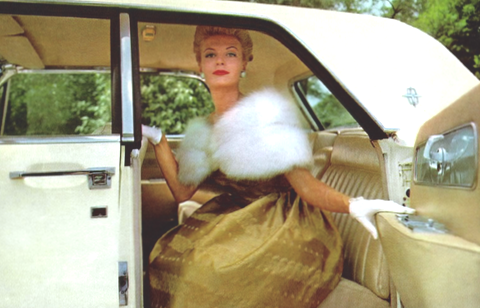James Kraus
Auto Universum celebrates the automobiles and automotive culture of the Jet Age with a particular focus on the 1960s. A global phenomenon, the Jet Age was particularly discernible from a U.S. vantage point. Here, Auto Universum takes a look back at this exciting milieu, the origins of which began in the mid-1950s.

It was an era of optimism and prosperity. In 1954, post-war food rationing finally ended in Britain, France was enjoying the height of The 30 Glorious Years and Germany was celebrating its Economic Miracle. In the U.S., Wall Street, Madison Avenue, Abstract Expressionism, Modernist architecture and Cool Jazz catapulted New York to the global epicentre of the intersecting worlds of art and commerce.
First and foremost, the latter-fifties were about enjoying life after two decades of depression and war followed by material shortages and wage and price controls in the U.S. instituted during the Korean War. In February of 1953 the latter were lifted, and in 1954 major stock markets finally began eclipsing marks set in September of 1929. The West was set to enter a period of seemingly unlimited prosperity and abundance.

In October of 1956 Fortune magazine published a glowing account of the booming consumer-driven U.S. economy stating, “Never has a whole people spent so much money on so many expensive things in such an easy way as Americans are doing today.” A few months later the magazine noted that the number of families moving into the middle class was increasing by over one million a year and projected that by the decade’s end, half the families in America would be included.
Millions of WW II veterans; graduating with G.I. Bill-financed college degrees, fueled the expansion, buying homes in burgeoning new suburban developments with low-interest zero down payment G.I. loans.

A mass migration to the suburbs saw new housing tracts spring up across the U.S. Many of these new subdivisions featured exclusively up-to-the minute Modernist homes, not just in newer areas like Palm Springs and Las Vegas but in more established locales as well, epitomized by such developments as Cumberland Estates in Knoxville Tennessee.
Other suburbs were built using modern floor plans like the Ranch and the Split-Level, but trimmed with traditional detailing including panelled doors and faux window shutters.

Regardless of architectural style, many new dwellings were furnished with at least a modicum of modernist furniture pieces in what was a Golden Age of furniture design. Taking cues from Danish Modern and Bauhaus styles, designers Bertoia, Eames, Jacobsen, Prouvé, Saarinen and others created intriguing new forms that were a complete break with the past.

Many examples were constructed of new materials developed during World War II including moulded plywood and rigid fibreglass-reinforced polyester resin.
As testament to their integrity, most of the pieces by the aforementioned designers remain in production to this day.

In addition to new styles of furniture, homes of the era were filled with the latest gizmos: televisions, washers and dryers, dishwashers, air conditioners, freezers, pressure cookers, blenders, barbeque grills, transistor radios, hula-hoops and the occasional aluminium Christmas tree.

Many new technologies developed during the war years attained large-scale commercial use in the 1950s: jet propulsion, rocketry, high-octane fuel, electronics, nuclear power, frozen food and freeze-dried coffee.
As the public unquestionably embraced new technology with open arms, new became synonymous with better. The highest accolade that could be bestowed upon any new product was new and improved. Powdered orange juice (Tang, 1959); why not? Even spewing smokestacks were seen as a sign of progress and economic vitality. To question scientific progress was to be marked a Luddite.

In a prized corner of the new living or family room would be a single-channel monaural Hi-Fi unit on which to listen to the latest Cool Jazz or Bossa Nova. Meanwhile teenagers could play Rock & Roll in their bedrooms on the Regency TR-1 pocket-size transistor radio introduced just in time for the Christmas shopping season of 1954.
In rather stark contrast to today, the fifties consumer embraced a generous colour palette. With the exception of the occasional contrasting roof, two-tone cars had been dwindling in popularity since the late 1930s as separate fenders became integrated into overall body design.

That trend began to reverse in 1950 when Ford introduced the Crestliner with a two-tone lower body. By decade’s end, two and even three-tone cars would be commonplace in a rainbow of colours including highly saturated turquoise and coral as well as the occasional pink.

Colour wasn’t limited to driveways; in 1953 Frigidaire introduced the first popular-priced appliances available in colour finishes. As an alternative to traditional white, buyers could now opt for Stratford Yellow or Sherwood Green. Other manufacturers responded with their own special palettes, and in short order all major kitchen appliances were being offered in a wide range of colour from pastel pink to charcoal grey.

Society was becoming increasingly mobile. Thousands of kilometres of Autobahn, Autoroute and Autostrada were being built. Construction of the American Interstate Highway System began in 1956 and the first phase of the M1 Motorway opened in 1959, while the introduction of the Comet, 707, Caravelle and DC-8 ushered in the Jet Age.

Abstract Expressionism with its emphasis on colour, texture and self-expression without regard for depth or perspective was the first American art movement to achieve world acclaim and was of sufficient power to shift the centre of the art world from Paris to New York. It was eventually dubbed American-Type Painting by art critic Clement Greenberg in 1955.
While some perceived and bemoaned the veneer of conformity in cookie-cutter suburbs and The Man in the Grey Flannel Suit; there were undercurrents of change bubbling beneath the surface in the form of the Beats of Greenwich Village and North Beach, and Marlon Brando and James Dean on the silver screen.
For the first time in American life, youth became a separately defined market, and the first to tap into it in a big way was Elvis Presley who sold up to $75,000 worth of records a day in 1956.

Sexual mores began loosening. Playboy, first published in March of 1953, was selling over one million copies per month by the end of the decade. Peyton Place, with its tales of lusty women, sold 60,000 copies in less than two weeks upon its release in 1956. Three years later, the racy Lady Chatterley’s Lover was ruled to be no longer obscene, paving the way a few years later for similar rulings regarding Naked Lunch and The Tropic of Cancer.
Rising standards of living fuelled a restaurant boom, and Continental Cuisine was all the rage: Coquilles Saint Jacques, Hungarian Goulash, Beef Stroganoff, Smörgåsbords, Weiner Schnitzel and countless other international delights. Diners also increasingly yearned for more than food; they wanted excitement. Tableside preparation and presentations à la flambé were especially popular at trendsetting mid-century stalwarts like Forum of the Twelve Ceasers in New York and Chicago’s Pump Room.

In 1957, Sputnik heralded the dawn of the Space Age. Every hour and a half, amateur radio operators around the world could hear the relentless beeping of the Soviet satellite as it orbited overhead at 18,000 mph.
The public, already enthralled with outer space and flying saucers, became even more enchanted. Galactic, planetary and satellite-themed imagery and appliqués began adorning automobiles, appliances, modernist apartment blocks, and commercial signage.
The space-themed Stardust Resort and Casino opened in 1958, just a few months before the unveiling of the Ford Galaxie.

The launch of Sputnik produced another side effect: the San Francisco Chronicle’s Herb Caen described the denizens of North Beach as being “far-out” as Sputnik, and thus christened them Beatniks. By decades’ end Beatnik characters would populate numerous Hollywood movies and enter American living rooms at 8:30 Tuesday evenings in the form of Maynard G. Krebs in The Many Loves of Dobie Gillis.

Favourable demographics and consistent sizable gains in productivity continued to fuel prosperity into the sixties throughout the industrialized world. Between 1954 and 1967, Australia, Germany, Italy, Japan and Sweden suffered not a single year of recession. The transition to suburban living continued unabated.

What would become known as the Swinging Sixties got off to an illustrious start in February 1960 with the opening of the first Playboy Club. A scant three months later, doctors in the U.S. were cleared to prescribe the Combined Oral Contraceptive Pill. A sexual revolution was underway.
A consequence of the exuberant spending frenzy of the late 1950s was a growing elasticity of the boundaries of good taste. By the close of the decade many consumers, from the upper classes to the materialism-renouncing members of the nascent Beat Generation, began eschewing the more ostentatious flamboyance of the era; particularly in regard to automotive styling. Architectural critic Lewis Mumford referred to late ‘50s American cars as Little more than four-wheeled insults to men of good taste.
Change was in the air and tastemakers and manufacturers alike responded, with the auto industry at the forefront.

Beginning with 1960 models, tail fins went on a diet, chrome trim was reduced and multi-colour exteriors became a rarity. The transition from fifties extravagance to sixties elegance was exemplified by the graceful new downsized 1961 Lincoln Continental. In stark contrast to its predecessor, its crisp unadorned flanks and timeless style merited a bronze medal from the Industrial Design Institute and allowed it to endure basically unchanged for five years, a feat heretofore unknown in the postwar U.S. market.
A declaration by President Kennedy before a joint session of Congress on 25 May 1961 of his intent to land a man on the moon before the end of the sixties accelerated the Space Race and set an ambitious and optimistic tone for the nascent decade.
The excitement and allure of space exploration was enhanced further with the launch of the Telstar communications satellite in 1962.

The satellite inspired an instrumental of the same name by a British musical group, The Tornados. The song, featuring the Space Age sound of the newly introduced Univox Clavioline keyboard, became a number one hit in both the U.K. and the U.S.
Even more so than in the late 1950s, fascination with jets, rocketry and interplanetary travel induced numerous manufacturers to christen their products with sobriquets that lent an infusion of Space Age glamour.

Exemplars of the new fashion included the Ford Starliner, Oldsmobile Jetstar, Plymouth Satellite; Accutron Astronaut and Spaceview wristwatches and the Rolex Space-Dweller.
Conversely, a mere three months following the launch of Telstar atop a Thor-Delta rocket, the world faced the potential downside of rocketry in the form of the Cuban Missile Crisis; a battle of wits over Russian ballistic missiles in Cuba versus U.S. missiles in Italy and Turkey. Many homeowners began considering or installing backyard bomb shelters, particularly in Finland, Sweden, Switzerland and the U.S.

Though resolved successfully, the event brought the Cold War to a head and created a dichotomy that smouldered in the subconsciousness of the 1960s; the limitless possibilities of space exploration versus the possibility of instantaneous nuclear annihilation.
The same year; all but overshadowed, The Port Huron Statement was released by the U.S. Students for a Democratic Society (SDS), a manifesto of societal policy recommendations. It would prove to be a portent of things to come.

To accommodate higher standards of living, suburban homes of the 1960s increasingly featured two-car garages and family rooms, the latter usually featuring woodgrain panelling and acoustic tile ceilings. These became the nexus for nearly all home activities save for cocktail parties, which were frequently reserved for the more formal living room.

Kitchen appliances became more sophisticated with self-defrosting refrigerators becoming commonplace, along with ranges featuring dual high-level ovens. The promise of inexpensive nuclear power generation led to a nationwide promotion of the all-electric home. Developers would affix qualifying houses with a bronze Live Better Electrically medallion adjacent to the front door.
Steakhouses and temples of Continental dining began sharing the restaurant stage with a newcomer; Pacific Island cuisine, generally marketed as Polynesian or Tiki.

Descended from Don the Beachcomber and Trader Vic’s, Tiki dining mushroomed in popularity in the 1960s after gathering additional momentum when Hawaii became America’s 50th state. It was dining as spectacle, featuring exotic decorations, flaming entrees and fantastical rum-based drinks served in fanciful mugs embellished with tropical fruits and swizzle sticks.

The public became enamoured with Tiki, donning Hawaiian print shirts and applying Polynesian motifs to commercial establishments, apartment buildings and interior décor. Disneyland opened the Enchanted Tiki Room. Satellite imagery that began adorning modernist buildings in the post-Sputnik fifties increasingly had to make way for carved Tiki gods in addition to two other newcomers: oversize chess figurines and outsized coach lamps.

Pop Art began displacing Abstract Expressionism in leading galleries. Appropriating imagery from advertising and popular culture, Pop was perfectly suited to the new decade of consumerism.
Helen Gurley Brown published Sex and the Single Girl, advising women how to enjoy the pleasures of single living and engaging in les affaires du Coeur.

The British launched a four-pronged assault on worldwide culture with The Beatles, James Bond films, Carnaby Street fashions and Twiggy, the Face of 1966.

The years from 1962 through 1966 saw the release of films and television shows whose derivatives still account for virtually half of the current top six movie franchises: Bond, Batman and Star Trek. During the same period, Surf and Hot Rod music became pop staples of the airwaves.

While record companies had courted youth culture in the 1950s with acts like Elvis Presley, the 1960s saw an explosion of consumer products directly marketed to the burgeoning youth market from soft drinks targeted at the Pepsi Generation to the Ford Mustang and Pontiac GTO.
Despite youth–oriented pop music dominating record charts, Frank Sinatra’s Strangers in the Night climbed to Number One on the U.S. Billboard Hot 100 charts in July 1966, and became the second best-selling song of the year in the U.K. The same year, the Dow Jones Industrial Average reached its peak for the decade.

The prosperity of the 1960s provided a veneer that masked festering social discontent on a number of fronts including concerns over civil rights, student unrest and increasing antiwar sentiment over the escalating conflict in Vietnam. Tensions came to a head in the Watts Riots of 1965 and the Newark Riots of 1967.
Environmental and automotive safety concerns were brought to the fore by two groundbreaking books, Silent Spring (1962) and Unsafe at any Speed (1965). Concerns over the issues raised would eventually culminate in the creation of the Environmental Protection Agency and the National Highway Traffic Safety Administration. These two U.S. governmental agencies quickly drafted legislation setting emission and safety requirements for all cars built or imported into the country beginning in 1968, inspiring similar regulations around the globe. The era of viewing automobiles strictly as benign and enjoyable personal transport was coming to a close.

Two key cultural happenings took place in 1967, the Monterey International Pop Festival in Northern California, followed a few months later by the dawning of the Age of Aquarius as Hair opened at an off-Broadway theatre in New York. The two events had a global impact, crystallizing the mid-decade ascent of youth culture that would quickly manifest itself in fashion, music and lifestyle.
The world would never look the same; or be the same. The following year would see rioting occur throughout the United States, Italy and France, followed in 1969 by the Days of Rage in Chicago, Bloody Sunday in Istanbul, and unrest throughout Northern Ireland.
Meanwhile; as P.J. O’Rourke once stated, looking forward went out of fashion. A predisposition to equate new and better swiftly evolved to new is suspect as tastes turned to Edwardian-era fashion influences and more traditionalist automotive design and architecture. 1967 saw both the release of Jacques Tati’s Playtime satirizing Modernism, and the demolition of the Monsanto Home of the Future at Disneyland’s Tomorrowland.

Another victim of changing attitudes was the American Supersonic Transport (SST) project originally begun in the halcyon days of 1963. While France and Britain pushed forward with Concord, the American SST was grounded.

Nevertheless, on 20 July 1969 in view of 600 million earthlings, astronauts Neil Armstrong and Buzz Aldrin would land on the moon, fulfilling the goal set by President Kennedy with five months to spare.